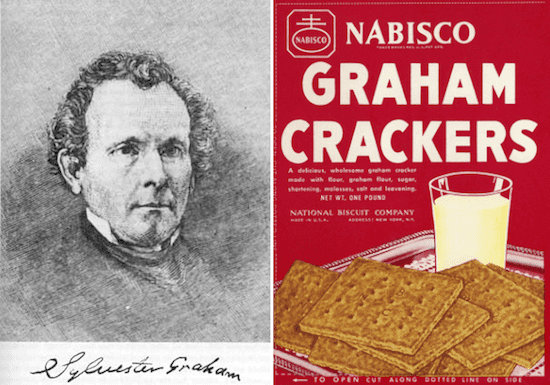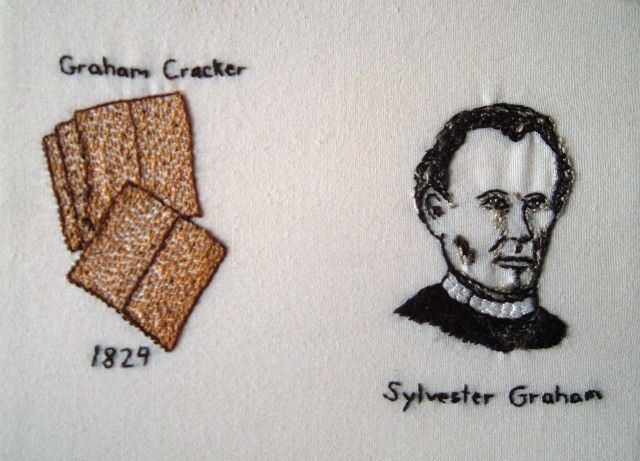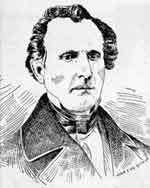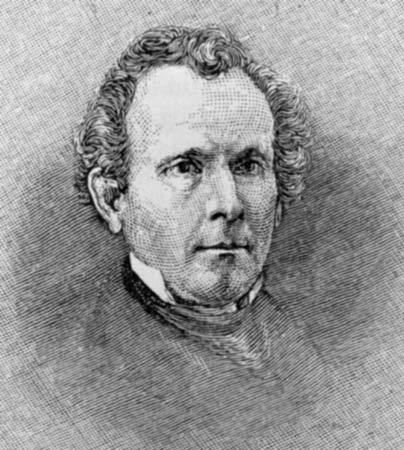Name Sylvester Graham | Education Amherst College | |
 | ||
Books A treatise on bread, and bread-making, Lectures on the Science of Human Life, A Lecture to Young Men Similar People Elizabeth Cady Stanton, Dorothea Dix, Horace Mann | ||
Dr sylvester graham
The Reverend Sylvester Graham (July 5, 1794 – September 11, 1851), a 19th-century Presbyterian minister, was an American dietary reformer, best known for his emphasis on vegetarianism, the temperance movement and his emphasis on eating whole-grain bread; he did not invent graham flour, graham bread, or graham crackers, but those products were inspired by his preaching.
Contents
- Dr sylvester graham
- the rise and fall of sylvester graham by nick johnson
- Biography
- Grahamites
- Graham on diet
- Grahams opinions on masturbation
- Selected works
- References

the rise and fall of sylvester graham by nick johnson
Biography

Graham was born in 1794 in Connecticut, to a family with seventeen children; his father was 70 years old when Graham was born and his mother was mentally ill. His father died when Graham was 2, and he spent his childhood moving from one relative's home to another. One of his relatives ran a tavern where Graham was put to work and his experience with drunkenness there led him to hate alcohol his whole life and forswear drinking, which made him an oddball among his peers at the time. He was often sick, and missed a great deal of schooling. He worked as a farm hand, cleaner, and teacher before deciding on the ministry as an antidote for his poor health. He entered Amherst Academy in his late twenties to become a minister as his father and grandfather had been, but was forced to leave when his schoolmates created a scandal by claiming he had improperly approached a woman. However, while he was at Amherst, his gift for oratory was first recognized.

He suffered a nervous breakdown as a result of his expulsion and moved to Rhode Island to recover, where he met the woman he married, who nursed him back to health. He studied theology privately, and in 1828 began working as an itinerant preacher in New Jersey.

In 1830 he was offered a position at the Philadelphia Temperance Society and accepted it. However, he quit the Temperance Society after six months to focus his preaching on health.
The Philadelphia Temperance Society was led not by ministers, as most other temperance societies were, but by doctors who were primarily concerned about health effects of alcohol. Moving in that company, Graham likely met two of the other fathers of American vegetarianism: William Metcalfe, an English minister who established a vegetarian church in Philadelphia, and William A. Alcott, a Philadelphia doctor who wrote extensively about vegetarianism and wrote the first American vegetarian cookbook. Graham taught himself about physiology and apparently arrived at his own conclusion that meat was just as much an expression and spur to gluttony as alcohol was, and that both corrupted both the body and soul of individuals and harmed families and society. He was influenced in that belief by the book of François-Joseph-Victor Broussais, Treatise on Physiology which was published in Philadelphia in 1826; the book claimed that what people ate had enormous influence on their health. Graham's interest was also captured by the books written by the German chemist, Friedrich Accum, called Treatise on Adulteration of Foods, and Culinary Poisons, in which he denounced the use of chemical additives in food and especially in bread, and Treatise on the Art of Making Good and Wholesome Bread; wheat flour at that time was often doctored to hide odors from spoilage, to extend it, and to whiten it, and bread was made from very finely ground flour (which Graham viewed as "tortured") and brewers yeast (used to make beer). Like other members of the temperance movement, Graham also viewed physical pleasure and stimulation, especially sexual stimulation, with suspicion as something that excited lust that led to behavior that harmed individuals, families and societies. Graham was also strongly influenced by the Bible and Christian theology in his own, idioscyncratic way; he believed that people should eat like Adam and Eve did in the Garden of Eden - only from plants - and he believed that plague and illness were not random, but rather were something that people exposed themselves to by living in ways that departed from natural law; he also urged people to remain calm, and not allow worry or lust to shake them from living rightly - perhaps one of the first people to claim that stress causes disease. From all this he created a theology and diet aimed at keeping individuals, families, and society pure and healthy - drinking pure water and eating a vegetarian diet anchored on bread made at home, from flour coarsely ground at home so that it remained wholesome and natural, and all without spices or other "stimulants" and a rigorous lifestyle that involved sleeping on hard beds and avoiding warm baths. This has been described as a very early example of preventive medicine. The emphasis on milling and baking at home was part of his larger vision of America in which women remained at home and nursed their families into health and maintained them there, as his wife had done for him.
His appointment and conversion to vegetarianism came as the 1829–51 cholera pandemic was breaking in Europe, and Americans were terrified that the epidemic would reach America. Accepted medical knowledge at that time, was that eating plenty of meat, drinking port wine, and avoid vegetables were the best way to prevent contracting cholera. People also believed that cholera was a plague sent by God to punish people.
As a skilled and fiery preacher, his strange message, combining patriotism, theology, diet, lifestyle, and messages already prevalent from the temperance movement captured the attention of the frightened public and outraged bakers and butchers, as well as the medical establishment. When the cholera epidemic reached New York in 1832, people who had followed his advice appeared to thrive, and his fame exploded. When he published his first book in 1837, Treatise on Bread and Bread-Making, his lectures in New York and Boston that year were thronged; the Boston lecture was disrupted by a threat of riots by butchers and commercial bakers.
In 1837 Graham and Alcott founded the "American Physiological Society" which lasted only three years.
As his fame spread, "Grahamism" became a movement and others, inspired by his preaching, began to develop and market graham flour, graham bread, and graham crackers; he neither invented nor endorsed any specific product, nor did he receive any money from their sale.
In 1850, William Metcalfe, William Alcott, Russell Trall, and Graham founded the American Vegetarian Society in New York City, modeled on a similar organization established in Great Britain in 1847. He died the following year at the age of 57 in Northampton, Massachusetts at his home. Graham influenced notable figures in America, including Horace Greeley and John Harvey Kellogg of Battle Creek Sanitarium fame.
Of his numerous writings, the best known were Lectures on the Science of Human Life (Boston, 1839), of which several editions of the two-volume work were printed in the United States and sales in England were widespread, and Lectures to Young Men on Chastity.
Grahamites
Grahamites, as Graham's followers were called, accepted the teaching of their mentor with regard to all aspects of lifestyle. As such, they practiced abstinence from alcohol, frequent bathing, daily brushing of teeth, vegetarianism, and a generally sparse lifestyle. Graham also was an advocate of sexual abstinence, especially from masturbation, which he regarded as an evil that inevitably led to insanity. He felt that all excitement was unhealthful, and spices were among the prohibited ingredients in his diet. As a result, his dietary recommendations were inevitably bland, which led to the Grahamites consuming large quantities of graham crackers, a concept inspired by Graham's teachings. White bread was strongly condemned by Graham and his followers, however, as being essentially devoid of nutrition, a claim echoed by dietitians ever since. Some Grahamites lost faith when their mentor died at the age of fifty-seven. Other than the crackers, the Grahamites' major contribution to American culture was probably their insistence on frequent bathing. However, Graham's doctrines found later followers in the persons of Dr. John Harvey Kellogg and his brother Will Keith Kellogg. Their invention of corn flakes was a logical extension of the Grahamite approach to nutrition.
Grahamism was influential in the vegan movement. Sylvester Graham focused on meat and milk, which he believed to be the cause of sexual urges. In fact, he claimed animal byproducts produced lust; Grahamism thus rejected meat, animal byproducts, and alcohol in order to develop a purer mind and body.
Quite popular in the 1860s–1880s, Grahamism rapidly lost momentum and is now remembered mostly for its graham crackers, even though graham crackers do not resemble the graham bread he ate.
Graham on diet
Around 1829, Graham invented the Graham diet, which consisted mainly of fresh fruits and vegetables, whole wheat and high fiber foods, and excluded meat and spices altogether (see vegetarianism). Very fresh milk, cheese, and eggs were permitted in moderation, and butter was to be used "very sparingly".
Graham believed that adhering to the diet would prevent people from having impure thoughts and in turn would stop masturbation (thought by Graham to be a catalyst for blindness and early death) among other things. He was a prolific writer and speaker for his cause, which was sternly opposed to "bad habits" of the body and mind. During the 1830s, the diet had a moderate response, mostly from the puritanical faction of the American public. At one point it was strictly imposed on students of Oberlin College by David Campbell (a disciple of Graham's). During the period in which it was enforced, some rebellious students ate off-campus, and at one point a professor was fired for refusing to stop bringing his own pepper for use with his meals. The diet was eventually dropped by the college in 1841 following a public outcry.
Graham's opinions on masturbation
As a Christian reform physiologist, Graham explored the relationship between sexuality and the mind, body, and health, rooting his beliefs in the Christian tradition. His piece On Self-Pollution, published in 1834, contributed to the masturbation scare in antebellum America. He believed youthful masturbation was dangerous to children's health because of the immaturity of their reproductive organs.
